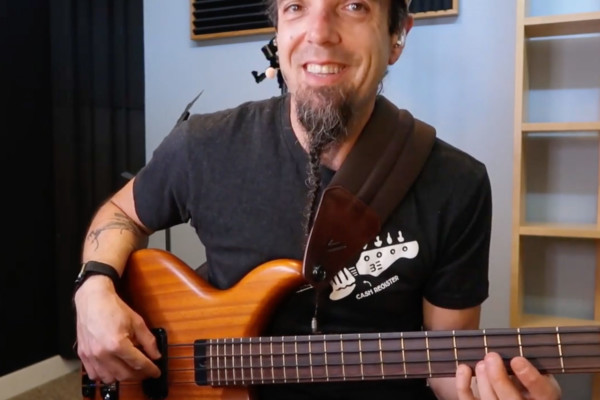Ask Damian Erskine
Q: What would be a good way to start practicing soloing over changes?
A: I’ll tell you what I worked on the most with the soloing thing.
Take a jazz standard (so there’s a lot of chord changes) and practice arpeggiating the chords through the tune. First, like a walking bass line (quarter notes…1, 3, 5, 7 of each chord) then in all inversions (3, 5, 7, 1….5, 7, 1, 3….7, 1, 3, 5…).
Then I practice trying to connect the chords in a more organic way. Like if I’m going from a D-7 to a GMaj7, and I play the D-7 chord arpeggio (D, F, A, C), instead of jumping back down to the G to start the pattern over, I’ll think of what note in the next chord is closest to me (kind of like voice leading)… So I might move from the C down to the B (3rd of the GMaj7 chord) and play the 1st inversion of that chord (the one that starts B, D, F#, G) and then move to the closest note of the next chord.
The next step is to do that in a freer environment (forget about straight arpeggios… you can even forget about time, etc.) but play around (in a musical way!) moving through the chords in every and any way you can think to.
Now you’ve got the chord tones down (the notes that definitely work over a chord). Now is the time to experiment with non-chord tones. But get those arpeggios down first!
That should help nail down the basics of the harmony.
Q: I’m getting frustrated at where I am musically. I practice a lot but can’t seem to get the dexterity together like guys like you or Matt Garrison, Hadrien Feraud, Janek Gwizdala, Tony Grey, etc… I also just don’t see how to play over complicated changes like that… Should I work on learning solos? Playing to a metronome all day? Any help would be greatly appreciated!
A: It’s really a combination of all of the things you mentioned. With the speed & dexterity thing, it’s a lot of really intentional practice. For example:
EVERY DAY, taking and inventing new patterns to challenge your fingers and work through them with a metronome slowly building up speed and articulation. It’s important to not practice them faster than you can play them cleanly (otherwise, you’re practicing sloppy articulation). I like to practice stuff like that with the tempo just before the edge of my comfort level. I’m playing it at a challenging tempo, but NOT at a tempo that I can’t hang with. I make sure I can play it cleanly through a few times and THEN notch up the tempo a few clicks. Slowly building the tempo while always being able to play it cleanly and with good tone/articulation!
Also, learning difficult music. Chick Corea heads, Jaco bass lines, Charlie Parker heads and solos, etc… Anything that you can play, learn to play it (again, starting slowly and build it up over time).
Also, learning about chords and trying to see your fingerboard from every angle. Learn every chord type and try and find as many ways to voice the chord as possible. Get a real book (jazz standards) practice chording through the song like a guitar player.
Learn to walk bass lines over the changes and then start practicing soloing. Learn the melody, etc…
It’s just a lot of work. The only thing that is different about guys like you mentioned (and I’m honored that you put me in that list! geesh!), for example is that we’ve really married our instruments. If I’m not playing bass, I’m thinking about it. When my turn signal is on in the car, I’m drumming to it and sub-dividing beats and trying to think of ways to play in 7 over the click.
I scour Youtube for great players and try and figure out what they’re doing, etc…
It’s really just a commitment and homework thing. But, if it’s what you love, it never feels like work. It’s just exciting that you might learn something new today. and each thing comes slowly, but they keep coming and eventually add up to ability and musical vocabulary.
Hope that helps!!
Q: So I have a book that shows me all of the modes, etc.. But I still don’t really know how to use them or make music out of them… I’m solid with my pentatonics but can’t make them sound like advanced harmony. I seem to get overwhelmed when looking at all of these different modes.
A: I totally know where you’re coming from with the pentatonics. It can be hard to learn how to use the other chord tones! The beautiful thing is, once you have the pentatonics, you have 5/7ths of all of the modes!! In other words…
Minor pentatonic = C Eb F G Bb C
Phrygian scale = C Db Eb F G Ab Bb C
Pentatonic has all notes but the b2 & b6. So you’re THAT close to already knowing the Phrygian scale, etc.. If you try and relate everything you’re learning to what you already know, it tends to come quicker.
Try this:
Set up a loop or play to a track that’s in one key, say C Major.
Play around with all of the modes starting on the corresponding scale degree.
For example, play in A minor (aeolian) for a while and then switch to, say, E Phrygian, D Dorian, etc… That’s a great way to experiment and & acclimate to the sound of the different modes.
Really, in the end you won’t be thinking of each mode so much as being more aware of your overall tonality and will have experience approaching that tonality from a number of different angles. It all adds up to fret-board proficiency and an understanding of how different notes interact with a given chord.
Q: I feel like I’m stuck and am not sure how to work on new ideas for soloing. I want to get better but am not sure what else I can do to GET better. Any suggestions?
A: Really, I started getting better at it when I started taking jazz gigs. Those are the hardest things to solo over! I then realized that if I could solo convincingly over jazz changes, I (felt like I) could do anything. I started working out over jazz changes (Autumn Leaves is a good one… kinda corny, but it has both Major and minor ii-v’s at one chord per bar).
- I worked on playing all of the arpeggios (1, 3, 5, 7) in all inversions throughout the tune, worked on
- I walking through tunes and not ever moving more than a whole or half step (forces you to think linearly and consider chord tones you might not otherwise think of landing on, etc…)
- I Playing chords and also trying to figure out new ways to voice the chords. The root doesn’t HAVE to be on the bottom!!
- I in addition to experimenting with Patterns (ie: playing in fourths, fifths, sixths, etc…to see what I came up with (“if I start on a G and play all fifths where do I end up after crossing 4 strings?”)
That, and focusing on learning how to NOT land on the root all of the time (really hard for a bass player!) and experiment with different tonal centers.
Eventually, on a good day, when you see a chord, you immediately see every possible note that would work on your neck and when you choose one and think of the next chord, you see more and more choices… I guess I’m also pretty into visualization and being able to see the neck in your mind.
I also used to work on playing things in my head and hearing the notes, practicing with my eyes closed (or in the dark)….REALLY helps when you can see all of the notes on your neck with immediacy (especially getting the middle of the neck…(7th-11th frets) as second nature as the first 5 frets. Writing bass lines to a set of changes (any style) whithout the bass in your hands (actually notating on paper, so you work on your reading as well). Writing solos on paper without the bass.
Also, try transcribing someone else’s solos!! Then take a look at them and try and see the music as they did. What are they playing over certain types of changes (II-V’s, etc..)? Do you hear any licks or repeated motifs? Figure them out, how do they work? This can be immensely helpful!
Q: Do you have any exercises or tips for developing walking bass lines?
A: In the abstract, walking is all about time and feel, I believe. Ultimately, it comes down to good tone and a great time-feel.
In practical terms, it’s fundamentally about connecting the chords and providing a strong harmonic foundation. You are the bridge between the drummer and the rest of the band. Time and feel is something that you just have to develop by playing with good musicians and LISTENING to not just yourself, but the band as a whole!
Harmonically speaking, I found that learning my chords and scales made walking come much more naturally… Try keeping it linear, too! (ie: walking in half and whole steps instead of arpeggiating everything).
As an excercise, take a set of changes:
- just play half-notes
- try not moving more than a whole step and walk up and down the neck… you’ll be missing some ROOTs but focus on what scale tones are available to you… After doing this for a while, go back and try to keep that idea in mind, but jump to more roots and 3rds here and there to solidify the harmony.
Walking is more about FEEL than notes, in my opinion. The notes have to work for the most part, but it’s more important that the FEEL is right… Altho, with modern electronics and especially with electric basses, our sound is SO much more present than it was 50 years ago so note choice has become much more important. You can’t fluff your way through the changes!
Try and make the line dance a little (not an easy thing to get across via the written word, but) make it rhythmically bouncy without being busy…
Sing this while tapping your foot.
|: Buuuuuum-ba-dum-ba-dum | dum-dum-dum-ba-diggity | dum-dum-dum-ba-dum |dum-dum-dum-dum-ba :|
Pay attention to which beats are stronger, as well
(beats 1 & 3 are STRONG beats… more important to outline chord tones there than beats 2 & 4, which are more transition beats and leave more room for chromatic approach notes, etc…).
Same thing goes for bars in a phrase.. Bars 1 & 3 are stronger harmonically than bars 2 & 4 which are more for transitions (meaning you can get away with more outside notes in bars 2 & 4).
Have a question for Damian?
Send it to [email protected]. We can’t promise every question will be answered, but we will read them all.
Have a question for Damian? Ask him!
Check out more Ask Damian Erskine columns
Have a question for Damian Erskine? Send it to [email protected]. Check out Damian’s instructional books, Right Hand Drive and The Improviser’s Path.




I know this article is a fair few years old now but it’s BRILLIANT!
Great building blocks for becoming a good Jazzer! Getting back to the shed. Thank you Damien :)
[…] I’ve written quite a few columns outlining how to practice this stuff, including how to figure out your own chord scales. […]